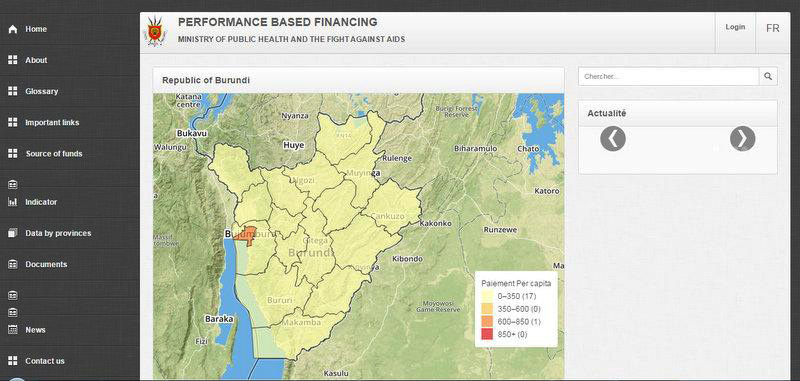Open Data for Developing Economies Case Studies
Burundi’s Open RBF
Making Health Spending and Performance Transparent
by Auralice Graft, Andrew Young, and Stefaan Verhulst
Reference
1 . Project conducted in collaboration with the Web Foundation, United States Agency for International Development (USAID), and the Mobile Solutions, Technical Assistance and Research (mSTAR) program at FHI 360.
2 . U.S. Global Health Initiative, “Burundi Global Health Initiative Strategy: 2011-2015,” September 2011, https://www.ghi.gov/wherewework/docs/BurundiStrategy.pdf.
3 . Trading Economics, “Burundi GDP Per Capita: 1960-2017,” http://www.tradingeconomics.com/burundi/gdp-per-capita.
4 . U .S. Global Health Initiative, “Burundi Global Health Initiative Strategy: 2011-2015,” September 2011, https://www.ghi.gov/wherewework/docs/BurundiStrategy.pdf.
5 . BBC News, “Burundi Country Profile,” December 14, 2016, http://www.bbc.com/news/world-africa-13085064
6 . Soeters Bonfrer, Presentation, Erasmus University, Rotterdam, 2015, http://rghi.nl/wp-content/uploads/2015/06/5.-Presentation-Igna-Bonfrer-PBF-in-Burundi-Bonfrer-et-al-Symposium-11062015.pdf.
7 . U .S. Global Health Initiative, “Burundi Global Health Initiative Strategy: 2011-2015,” September 2011, https://www.ghi.gov/wherewework/docs/BurundiStrategy.pdf.
8 . RBF is sometimes also referred to as performance based financing (PBF) or output based aid (OBA). In some contexts, PBF refers specifically to RBF in the health care sector. See Jurien Toonen, et al., Learning Lessons on Implementing Performance Based Financing, from a Multicountry Evaluation, Royal Tropical Institute, Cordaid and WHO, May 2009, http://www.who.int/contracting/PBF.pdf.
9 . Swedish International Development Cooperation Agency, Results Based Financing Approaches: What are they? SIDA, 2015, http://www.sida.se/contentassets/1869345299754bddbf58857e2d92c726/110557c1-7b5e-4a0d-97b0-cbeae5258533.pdf.
10 . György Bèla Fritsche, Robert Soeters and Bruno Meessen, Performance-Based Financing Toolkit, Washington, DC: World Bank, 2014, http://www.oecd.org/dac/peer-reviews/PBF-%20toolkit.pdf.
11 . See Jurien Toonen, et al., Learning Lessons on Implementing Performance Based Financing, from a Multicountry Evaluation, Royal Tropical Institute, Cordaid and WHO, May 2009, http://www.who.int/contracting/PBF.pdf
12 “RBF IT system for Education sector in Burundi.” OpenRBF, http://www.openrbf.org/project/rbf-it-system-for-education-sector-in-burundi/Ve_9qR8AABUBfdDj.
13 . See: https://www.cordaid.org/en/.
14 . GovLab interview with Antoine Legrand and Elena Ignatova, Program Managers at BlueSquare, August 9, 2016.
15 . GovLab interview with Elena Ignatova, Program Manager at BlueSqure, January 19, 2017.
16 . Christel Jansen and Jurrien Toonen,“Learning from Experiential Performance Based Financing Knowledge in Burundi and Cameroon,” KIT Health Blog, June 21, 2016, https://www.rbfhealth.org/blog/learning-experiential-performance-based-financing-knowledge-burundi-and-cameroon.
17 . György Bèla Fritsche, Robert Soeters and Bruno Meessen, Performance-Based Financing Toolkit, Washington, DC: World Bank, 2014, http://www.oecd.org/dac/peer-reviews/PBF-%20toolkit.pdf.
18 . Aléa Kagoyire, “Inspiring Change in Burundi’s Education System with OpenRBF, BlueSquare.org, March 17, 2016, https://medium.com/@BlueSquare.org/inspiring-change-in-burundi-s-education-system-with-openrbf-by-al%C3%A9a-kagoyire-project-manager-af1fbb6d31d9#.ac8i9w7es.
19 . See: http://www.bluesquare.org/technologies.
20 . Alice Irakoze, “An OpenRBF portal for the Community PBF in Makamba, Burundi: verified data, transparent management and budget monitoring !” BlueSquare.org, July 17, 2015, https://medium.com/@BlueSquare.org/an-openrbf-portal-for-the-community-pbf-in-makamba-burundi-verified-data-transparent-management-8afc0610fd99#.tyefjelsl.
21 . See: http://www.openrbf.org/faq.
22 . Ministere de la Sante Publique et de la Lutte Contre Le SIDA, Performance Based Financing, 2013, http://www.fbpsanteburundi.bi/data/indicators.html#dataelt11.
23 . Cordaid, “Open RBF,” https://www.cordaid.org/en/topics/healthcare/result-based-financing/open-rbf/.
24 . GovLab interview with Elena Ignatova, Program Manager at BlueSqure, January 19, 2017.
25 . Republic of Burundi, Ministry of Public Health and the Fight Against AIDS, “Evaluation Final de Projet Pilote FBP Communautaire au Burundi,” December 2015.
26 . GovLab interview with Simone Soeters, Cordaid Program Manager and Vincent Kamenyero, Cordaid, September 22, 2016.
27 . GovLab interview with Dr. Etienne Nkeshimana, Cordaid Community RBF Coordinator, and Simone Soeters, Cordaid Program Manager, September 13, 2016.
28 . Cordaid, “Open Development Movement: Co-creation leads to transformation,” Position Paper, May 2014, https://www.cordaid.org/en/wp-content/uploads/sites/3/2014/05/OpenDevPaper-MAY2014-LR_5.pdf
29 . GovLab interview with Antoine Legrand and Elena Ignatova, Program Managers at BlueSquare, August 9, 2016.
30 . GovLab interview with Dr. Etienne Nkeshimana, Cordaid Community RBF Coordinator, and Simone Soeters, Cordaid Program Manager, September 13, 2016.
31 . Ibid.
32 . Ibid.
33 . Cordaid, “Open Development Movement: Co-creation leads to transformation,” Position Paper, May 2014, https://www.cordaid.org/en/wp-content/uploads/sites/3/2014/05/OpenDevPaper-MAY2014-LR_5.pdf.
34 . GovLab interview with Dr. Etienne Nkeshimana, Cordaid Community RBF Coordinator, and Simone Soeters, Cordaid Program Manager, September 13, 2016.
35 . Ibid.
36 . Alice Irakoze, “Un portail OpenRBF pour le FBP communautaire à Makamba, Burundi : des donnéees verifiées, une gestion et un suivi budgétaire transparents!” BlueSquare.org, https://medium.com/@BlueSquare.org/un-portail-openrbf-pour-le-fbp-communautaire-%C3%A0-makamba-burundi-des-donn%C3%A9ees-verifi%C3%A9es-une-f419eb6b6ebc#.ptx0n29b4.
37 . GovLab interview with Antoine Legrand and Elena Ignatova, Program Managers at BlueSquare, August 9, 2016.
38 . Cordaid, “Open Development Movement: Co-creation leads to transformation,” Position Paper, May 2014, https://www.cordaid.org/en/wp-content/uploads/sites/3/2014/05/OpenDevPaper-MAY2014-LR_5.pdf.
39 . GovLab interview with Antoine Legrand and Elena Ignatova, Program Managers at BlueSquare, August 9, 2016.
40 . Ibid.
41 . Aléa Kagoyire, “A New Mobile Data Collection Tool Is Out!” BlueSquare.org, July 17, 2015, https://medium.com/@BlueSquare.org/a-new-mobile-data-collection-tool-is-out-c3746ae4233d#.alv6gelpm.
42 . Alice Irakoze, “Un portail OpenRBF pour le FBP communautaire à Makamba, Burundi : des donnéees verifiées, une gestion et un suivi budgétaire transparents!” BlueSquare.org, https://medium.com/@BlueSquare.org/un-portail-openrbf-pour-le-fbp-communautaire-%C3%A0-makamba-burundi-des-donn%C3%A9ees-verifi%C3%A9es-une-f419eb6b6ebc#.akspjkv9h.
43 . Nicolas de Borman, “How Can New Technologies Enhance Efficiency and Good Governance of Results-based Financing,” RBFHealth Blog, July 16, 2014, https://www.rbfhealth.org/blog/how-can-new-technologies-enhance-efficiency-and-good-governance-results-based-financing
44 . Alfred Antoine U., “Efficient Health Financing:Transparency, accountability and benchmarking in health systems,” Open RBF Initiative, October 22, 2013, http://www.health4africa.net/wp-content/uploads/local_health_systems_future_technology_impact_OPENRBF_Data.pdf.




